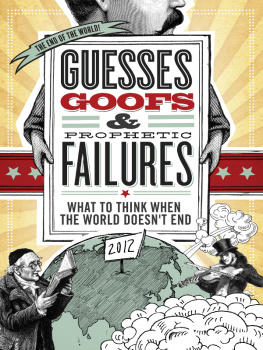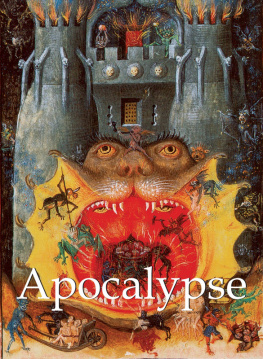Table of Contents
Advance Praise for Apocalypse Not
This concise book is a potent antidote to the apocalypse meme. Thank you, John Michael Greer, for showing how the apocalypse virus isnt fatal, but chronic.
Douglas Rushkoff, author of Life Inc.
and Program or Be Programmed
This sweeping survey of apocalyptic thought during the last three and a half millennia is written with erudition and sprinkled with humor. John Michael Greer seamlessly weaves the threads of religious /mystical and secular/revolutionary apocalypticismfrom the best-known exemplars to the delightfully obscure. I am confident this notable work will be around long after winter solstice 2012, continuing to serve the reader with its important explication of this critical subject and pointing the way to associated literature for further study.
James Wasserman, author of The Temple of Solomon: From
Ancient Israel to Secret Societies
It was important for somebody to take on this faux-religious madness, this yearning for the death of our planet. Hooray for John Michael Greer for skewering the lot of them on his acerbic pen! From the artificial counting of the dates of the end of the world to the last big bout of robbing people of their money, hopes, and religious beliefs, Greer tracks this male madness faithfully. This seems to be a very American obsession, the end of days, profitable to those who spread it, a doom to those who drink their Kool-Aid.
Z Budapest, author of
Celestial Wisdom for Every Year of Your Life and
The Holy Book of Womens Mysteries
The perfect hangover cure for the day before the day after the day the world didnt end.
Lon Milo DuQuette, author of
The Key to Solomons Key
Apocalypse Not is a riotous romp through the history of the human imagination. Mr. Greer takes us around the world and across millennia, from sacred to secular, to bring us this tribute to the limitless creativity and tenacious desire of the human heart despite all odds. The book details our human need to seek a utopian world, a world available only to the worthy by a trial that makes it worthwhile. He proves its not the Armageddon that draws us to embrace the idea of a pending apocalypse, but the dream of the paradise that lies beyond. Reading this book will make you laugh at human folly and cry at its consequences, as you meet some of the most colorful figures in history.
Jeff Hoke, author of The Museum of Lost Wonder
If peddling flesh is the worlds oldest profession, John Michael Greer makes a good case that peddling fear is not too far behind. Apocalypse Not lucidly spells out how social upheavalas well as plain old boredom and frustrationhave always inspired fantasies of The Great Reboot, when lions will lay down with lambs, streets will be paved with gold, and lowly stock boys will become lofty CEOs. This book explains the hows and whys of such grand fantasies throughout history and how often they seem to come to grief. Armageddon through to you?
Christopher Knowles, author of
The Secret History of Rock n Roll and Our Gods Wear Spandex
Look no further than Apocalypse Not for your explanation of 2012 end times, apocalypse memes, starlore, and pseudo-philosophers in mans rich history of end-of-the-world obsessions.
Nick Belardes, author of Random Obsessions
Apocalypse Not breaks open the doomsday clock, revealing all its cogs and inner workings. The end isnt near: its Greer.
Clint Marsh, author of The Mentalists Handbook
FOREWORD:
COUNTING DOWN TO THE APOCALYPSE
In the old Chinese calendar it will be the ninth day of the eleventh lunar month, at the end of the period Daxue, Great Snow, in the year of the Monkey 4649. Muslims around the world will call it Yaum al-Juma, the eighth day of Safar in the year 1434 after the Hegira, while the Hindu calendar gives the date as Sukravara, the seventh day of Margashirsha in the year 1934 of the akya era and 5113 of the Kali Yuga, the last and darkest age of this cycle of the world.
In the Julian calendar of ancient Rome, the same date would have been the sixth day before the Ides of December in the year 2765 from the founding of Rome, while the French revolutionary calendar, that weird and almost forgotten offspring of Enlightenment rationalism, would have called that day Primidi in the first decade of the month of Nivose in the year of the Revolution 221. The ancient Egyptians would have called it the sixth day of Pachon, though they would have had a hard time putting a number to the yearEgyptian years were counted from the start of the current pharaohs reign, and this sixth of Pachon will come more than two millennia after the last Lord of the Two Lands went to dwell with his divine father Osiris in the heavens of Amentet. The Western world will call it Friday, December 21, 2012.
More than a thousand years ago, the astronomers and mathematicians of another ancient people worked out this same date in their own calendar, and set in motion a chain of events that made their calculations a topic of fear and fascination across much of the world today. They were the Mayans, and to them the date in question was 4 Ahau 3 Kankin 13.0.0.0.0the end of the thirteenth and final baktun of the current great cycle of time, and, according to a widespread modern belief, the end of the world.
According to claims you can find retailed at great length in an abundance of books these days, the ancient Mayans were unlike any other people in history. They appeared suddenly out of nowhere thousands of years ago, complete with a culture and a technology that was unrelated to those of their neighbors and showed no signs whatsoever of gradual development over time, and they vanished just as suddenly a little more than a thousand years ago, abandoning their great stone cities to the jungle. Among their greatest achievements was a fantastically accurate and complicated calendar that includes a precise countdown to the end of the world. On December 21, 2012, that calendar comes to an end, and a vast body of ancient Mayan prophecies announce the coming of cataclysmic change on that date.
As it happens, almost none of this is true. The ancient Mayans existed, of course, and built a brilliant and highly creative civilization in the Yucatan peninsula and the rain forests just south of it, but they didnt appear out of nowhere and they didnt vanish into thin air. Archeologists in the Mayan region can show you sites where, long before the founding of the first Mayan cities, the basic elements that later became central to Mayan culture gradually came together, and excavations elsewhere in Mexico have shown that many of the things that todays popular culture assigns to the Mayans were originally invented by older culturesthe Zapotecs of the even more ancient site of Monte Alban, for example, were using the Mayan calendar long before the Mayans got around to it.
As for their disappearance, the great Mayan city-states of the southern lowlands went through a period of severe decline in the tenth century CE, involving warfare, famine, and the abandonment of most of the large urban centers, but the villagers of the countryside remained, and their descendants still live in the same area today. Elsewhere in the Mayan world, city-states on the classic model continued to flourish until the Spanish conquest of the Yucatan and Central America in the sixteenth and seventeenth centuries, and there are still plenty of people descended from the ancient Mayans, and who speak Mayan languages, throughout that part of the world.











